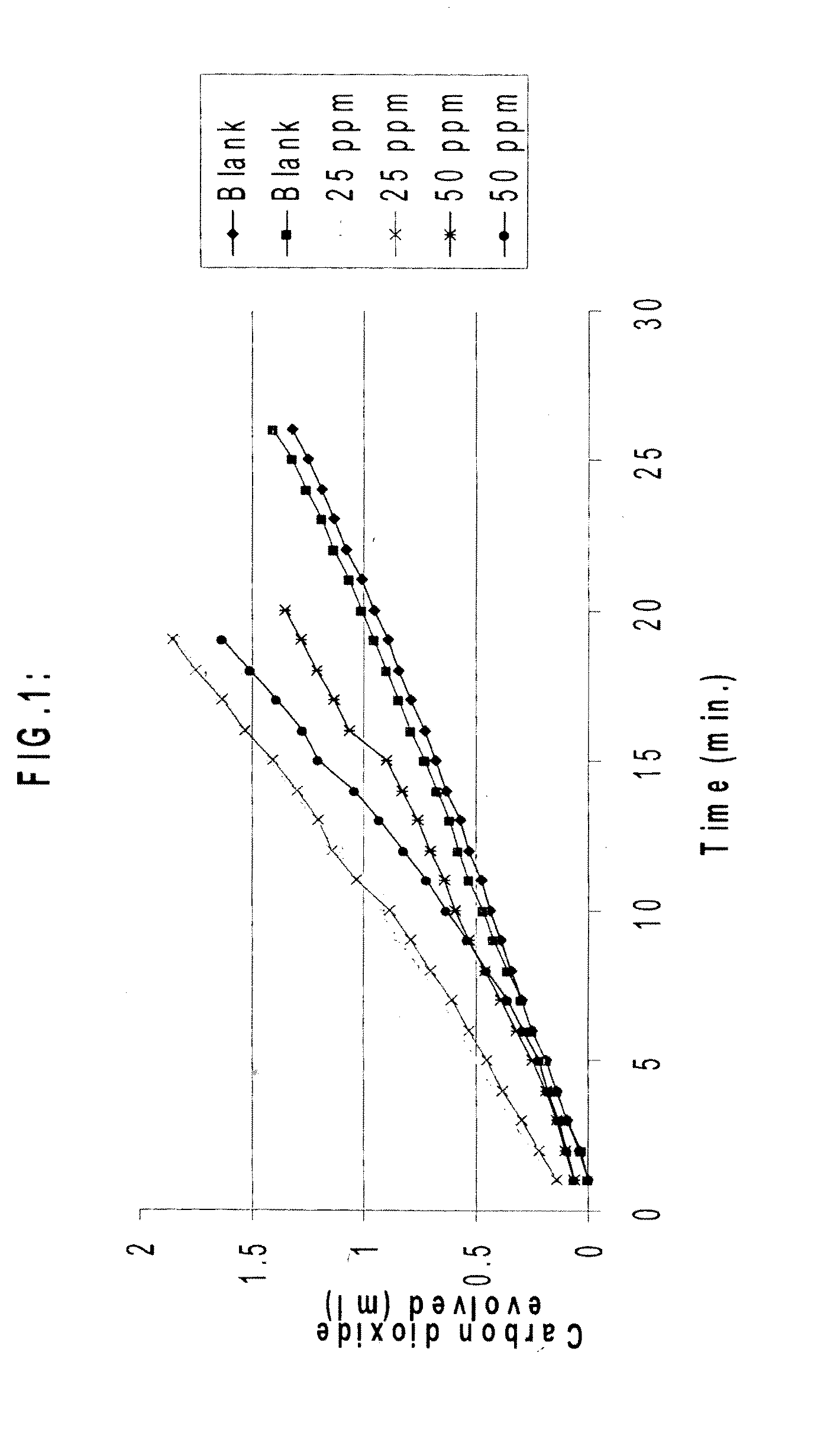Composition and Methods for Improving the Production of Fermentation Operations
a technology of fermentation and composition, applied in the field of composition and methods for improving fermentation, can solve the problems of contaminating microorganisms, reducing the yield of bioethanol, and affecting the production efficiency of bioethanol, so as to and improve the production rate and/or yield of non-terpene organic compounds.
- Summary
- Abstract
- Description
- Claims
- Application Information
AI Technical Summary
Benefits of technology
Problems solved by technology
Method used
Image
Examples
example 1
[0054]This example illustrates formulations of several embodiments of the terpene and surfactant oil-in-water emulsion of the present invention.
[0055]Emulsions A-Q were prepared by first dispersing the surfactants in water, followed by addition of the terpene with vigorous mixing.
Emulsion A: (HLB 14.2)Wt %d-limonene5.0oleyl alcohol 10 EO4.5Tween 203.0waterbalance
Example B (HLB 12.2)Wt %d-limonene5.0 oleyl alcohol 10 EO6.75Span 200.75waterbalance
Example C (HLB 15.5)Wt %d-limonene5.0hexadecane5.0stearyl alcohol 20 EO15.0 castor oil 80 EO5.0waterbalance
Example D (HLB 15.5)Wt %d-limonene5.0isoparaffin5.0stearyl alcohol 20 EO15.0 Castor oil 80 EO5.0waterbalance
Example EWt %d-limonene10.0 Tergitol NP66.0Diacid 15504.0dipropyleneglycol methyl ester2.0waterbalance
Example FWt %d-limonene5.0Diacid 15503.0decyl alcohol 4 EO3.0dipropyleneglycol methyl ester2.0waterbalance
Example GWt %d-limonene5.0Dowanol DB2.0Demulse DLN 532 CE8.0waterbalance
Example I (HLB 10.2)Wt %d-limonene10.0 Span 203.75Twe...
example 2
[0056]This illustrates the effect of the addition of a d-limonene emulsion on the rate of CO.sub.2 evolution in the fermentation of glucose by brewer's yeast.
[0057]A mixture of d-glucose (1 gram) was mixed with 14 ml of distilled water in each of six flasks. In each of six separate flasks, a sample of brewer's yeast (1 gram of Saccharomyces cerevisiae, Muntons dry brewer's yeast, available from Muntons PLC, Cedars Maltings, Stowmarket, Suffolk, IP14 2AG UK) was mixed with 10 g distilled water for 30 minutes at 30.degree. C. The yeast mixtures were added to the glucose solutions and the resulting mixtures (24 ml in each of six flasks) were mixed for 5 minutes. Two flasks (1 and 2) were blanks (having no terpene / surfactant emulsion), and various amounts of a terpene / surfactant emulsion was added to the remaining four flasks. Two flasks (3 and 4) each contained 25 ppm by weight of Emulsion O, as shown in Example 1, and the remaining two flasks (5 and 6) each had 50 ppm of the same emul...
example 3
[0061]This example illustrates the effectiveness of an embodiment of the present method in increasing the viability of yeast and improving the maintenance requirements in a commercial ethanol plant.
[0062]These tests were run in a commercial fuel ethanol plant that used corn as the substrate.
[0063]Different amounts of the terpene / surfactant emulsion of Example N of Example 1 were added to commercial fermenters at different stages of batch fermentations. In test “A”, 50 ppm of Example N was added to the medium in a fermenter at a time that was about 3 hours before the end of the fermentation. Total batch fermentation time was usually about 10-120 hours. At the time of addition of the emulsion, total yeast count was 282 (yeast count by light microscopy per unit area) with viable yeast count of 221 (21% dead yeasts), and where 28.5% of the live yeasts were budding. At the end of the fermentation, 3 hours later, total yeast count was 224 with a viable yeast count of 192 (14% dead yeasts)...
PUM
 Login to View More
Login to View More Abstract
Description
Claims
Application Information
 Login to View More
Login to View More - R&D
- Intellectual Property
- Life Sciences
- Materials
- Tech Scout
- Unparalleled Data Quality
- Higher Quality Content
- 60% Fewer Hallucinations
Browse by: Latest US Patents, China's latest patents, Technical Efficacy Thesaurus, Application Domain, Technology Topic, Popular Technical Reports.
© 2025 PatSnap. All rights reserved.Legal|Privacy policy|Modern Slavery Act Transparency Statement|Sitemap|About US| Contact US: help@patsnap.com

